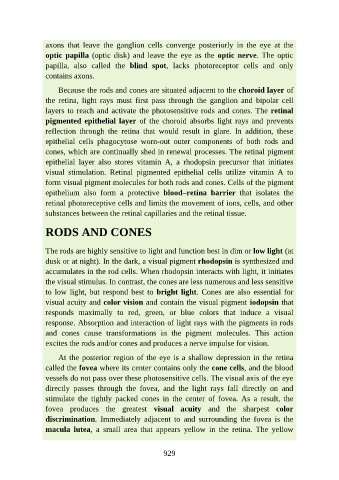Page 930 - Atlas of Histology with Functional Correlations
P. 930
axons that leave the ganglion cells converge posteriorly in the eye at the
optic papilla (optic disk) and leave the eye as the optic nerve. The optic
papilla, also called the blind spot, lacks photoreceptor cells and only
contains axons.
Because the rods and cones are situated adjacent to the choroid layer of
the retina, light rays must first pass through the ganglion and bipolar cell
layers to reach and activate the photosensitive rods and cones. The retinal
pigmented epithelial layer of the choroid absorbs light rays and prevents
reflection through the retina that would result in glare. In addition, these
epithelial cells phagocytose worn-out outer components of both rods and
cones, which are continually shed in renewal processes. The retinal pigment
epithelial layer also stores vitamin A, a rhodopsin precursor that initiates
visual stimulation. Retinal pigmented epithelial cells utilize vitamin A to
form visual pigment molecules for both rods and cones. Cells of the pigment
epithelium also form a protective blood–retina barrier that isolates the
retinal photoreceptive cells and limits the movement of ions, cells, and other
substances between the retinal capillaries and the retinal tissue.
RODS AND CONES
The rods are highly sensitive to light and function best in dim or low light (at
dusk or at night). In the dark, a visual pigment rhodopsin is synthesized and
accumulates in the rod cells. When rhodopsin interacts with light, it initiates
the visual stimulus. In contrast, the cones are less numerous and less sensitive
to low light, but respond best to bright light. Cones are also essential for
visual acuity and color vision and contain the visual pigment iodopsin that
responds maximally to red, green, or blue colors that induce a visual
response. Absorption and interaction of light rays with the pigments in rods
and cones cause transformations in the pigment molecules. This action
excites the rods and/or cones and produces a nerve impulse for vision.
At the posterior region of the eye is a shallow depression in the retina
called the fovea where its center contains only the cone cells, and the blood
vessels do not pass over these photosensitive cells. The visual axis of the eye
directly passes through the fovea, and the light rays fall directly on and
stimulate the tightly packed cones in the center of fovea. As a result, the
fovea produces the greatest visual acuity and the sharpest color
discrimination. Immediately adjacent to and surrounding the fovea is the
macula lutea, a small area that appears yellow in the retina. The yellow
929

